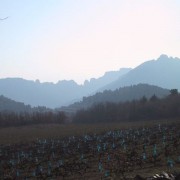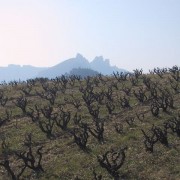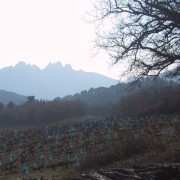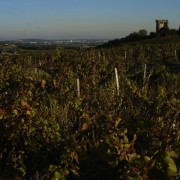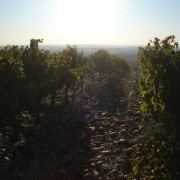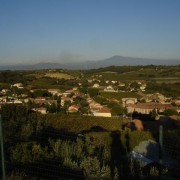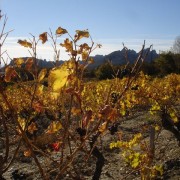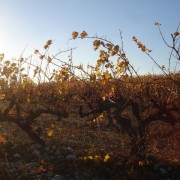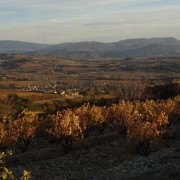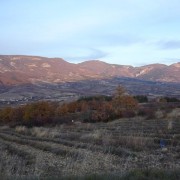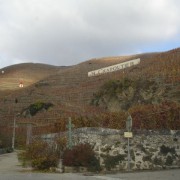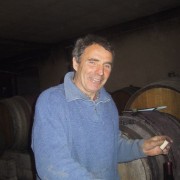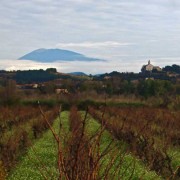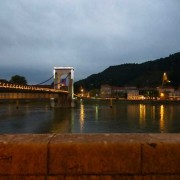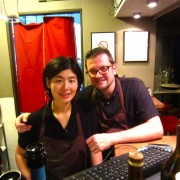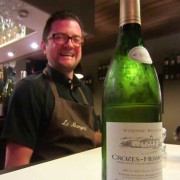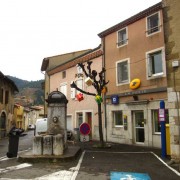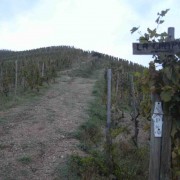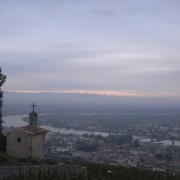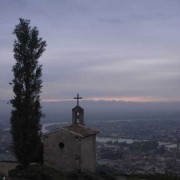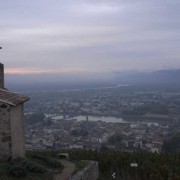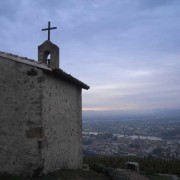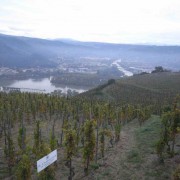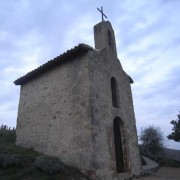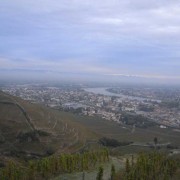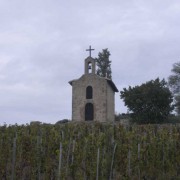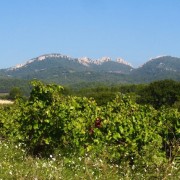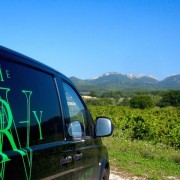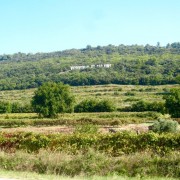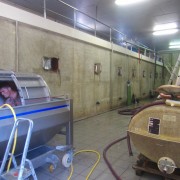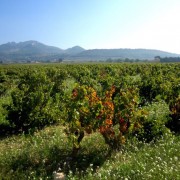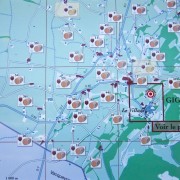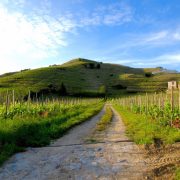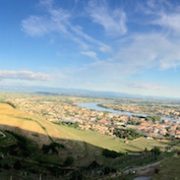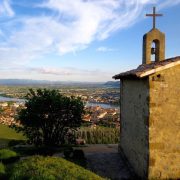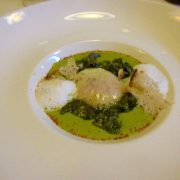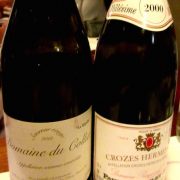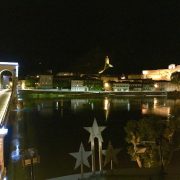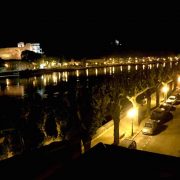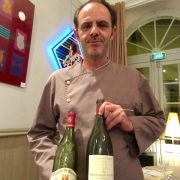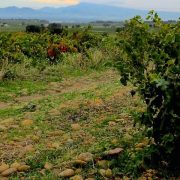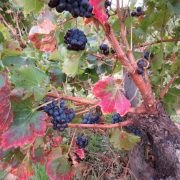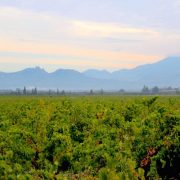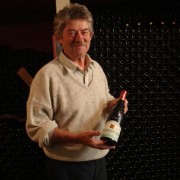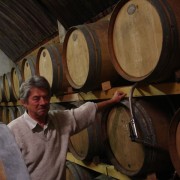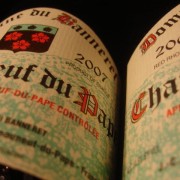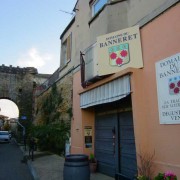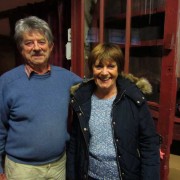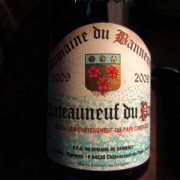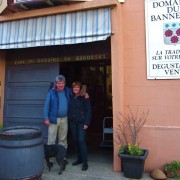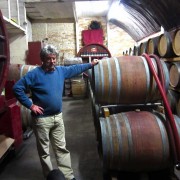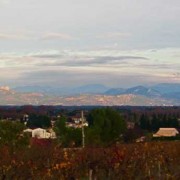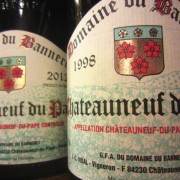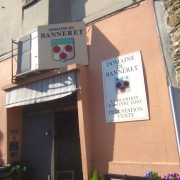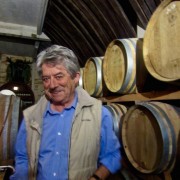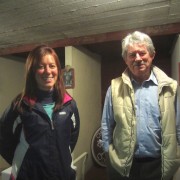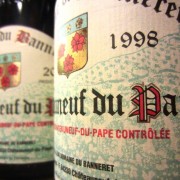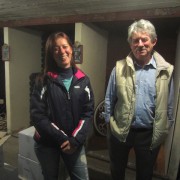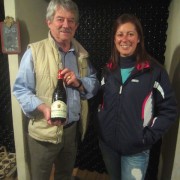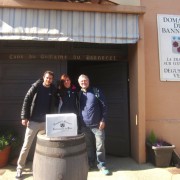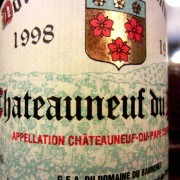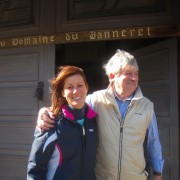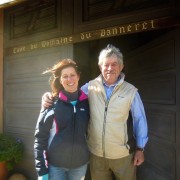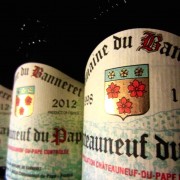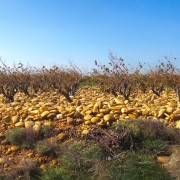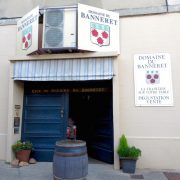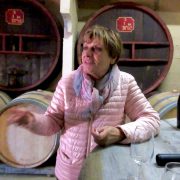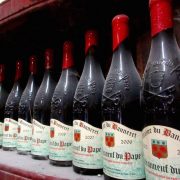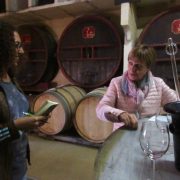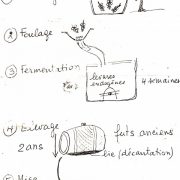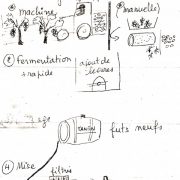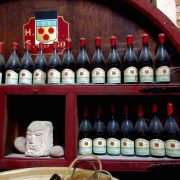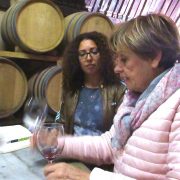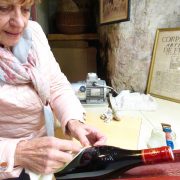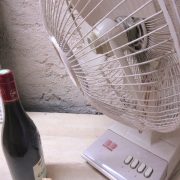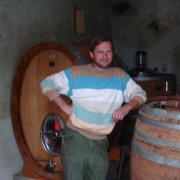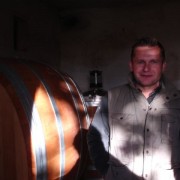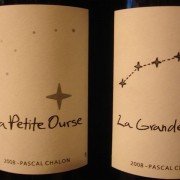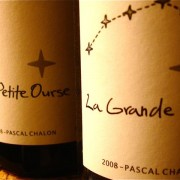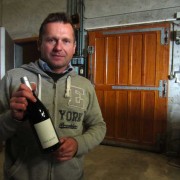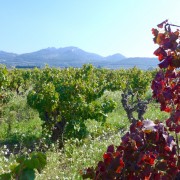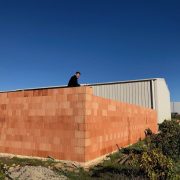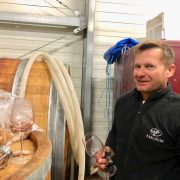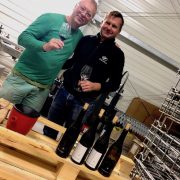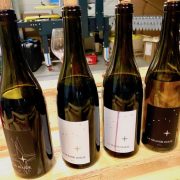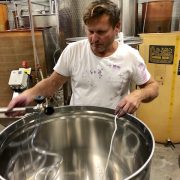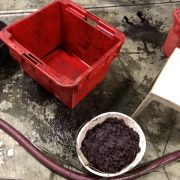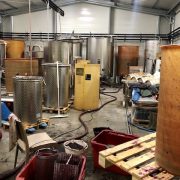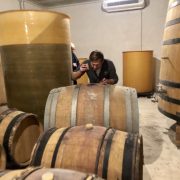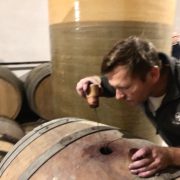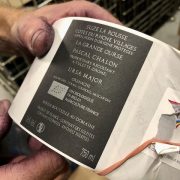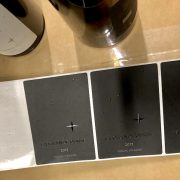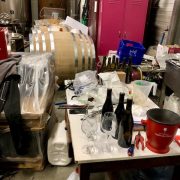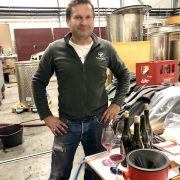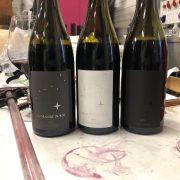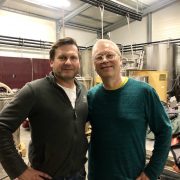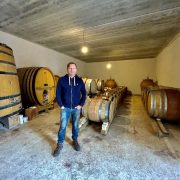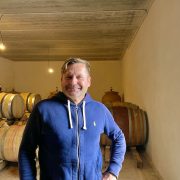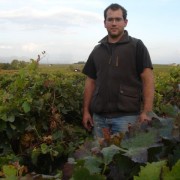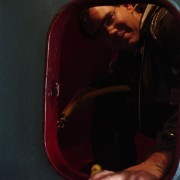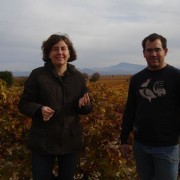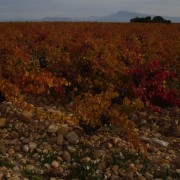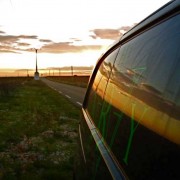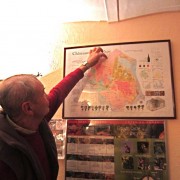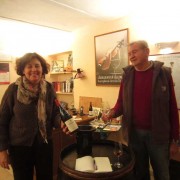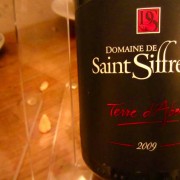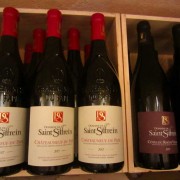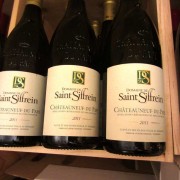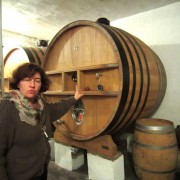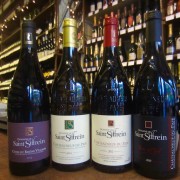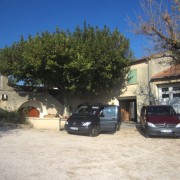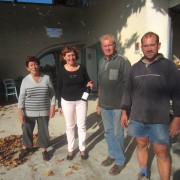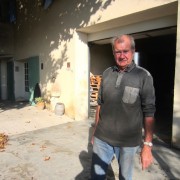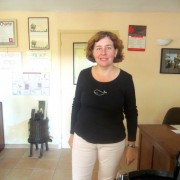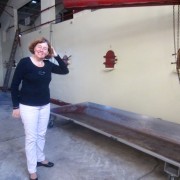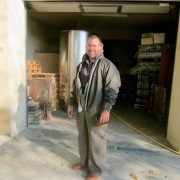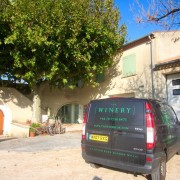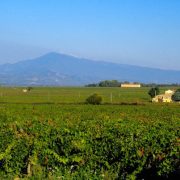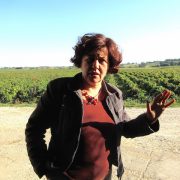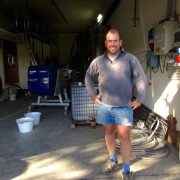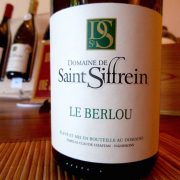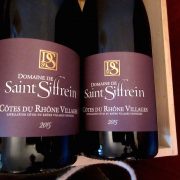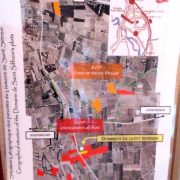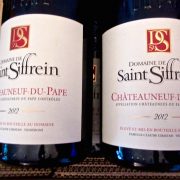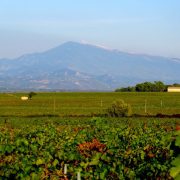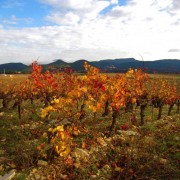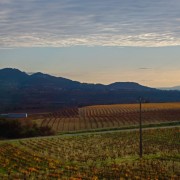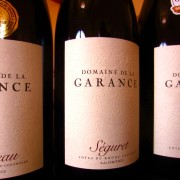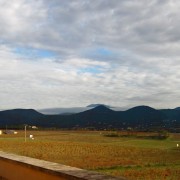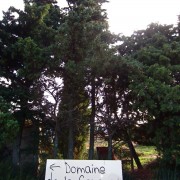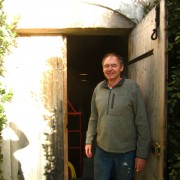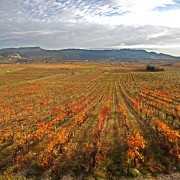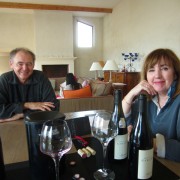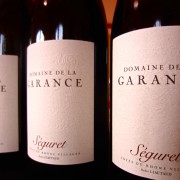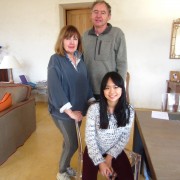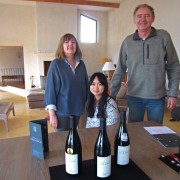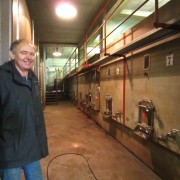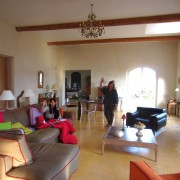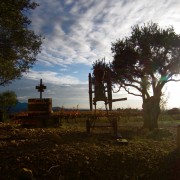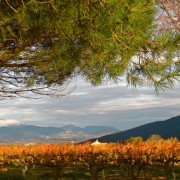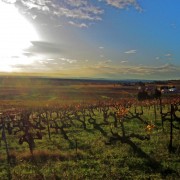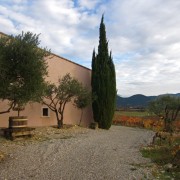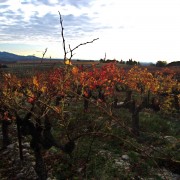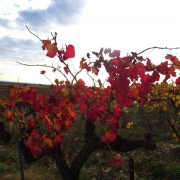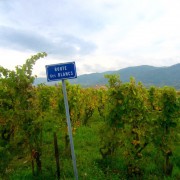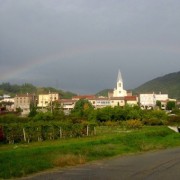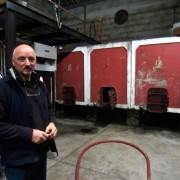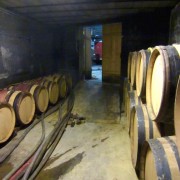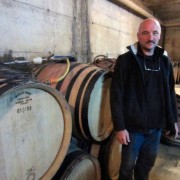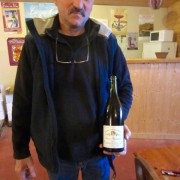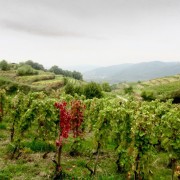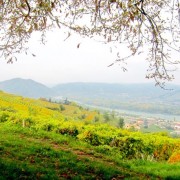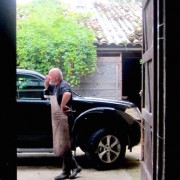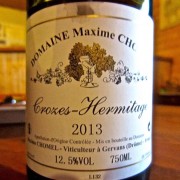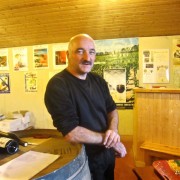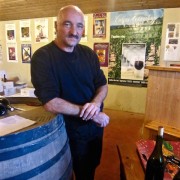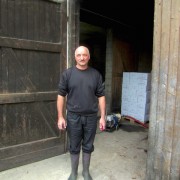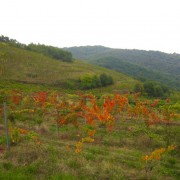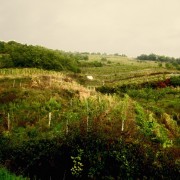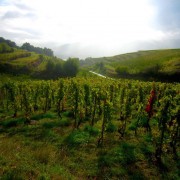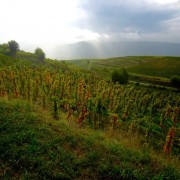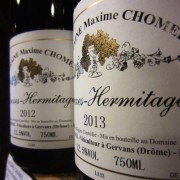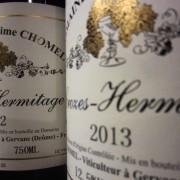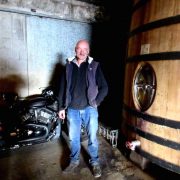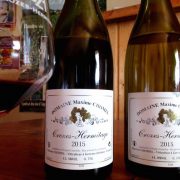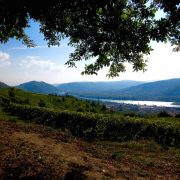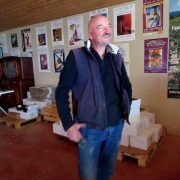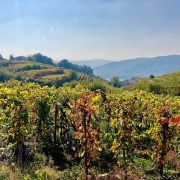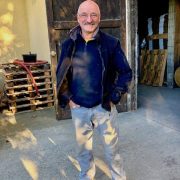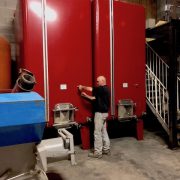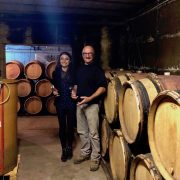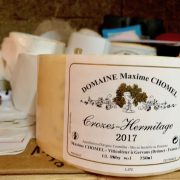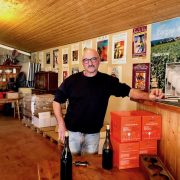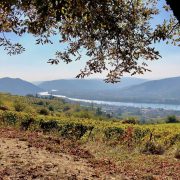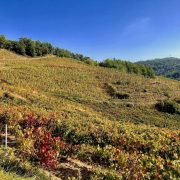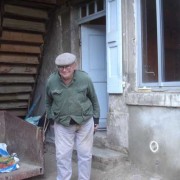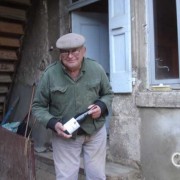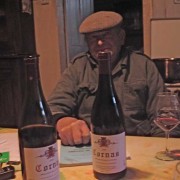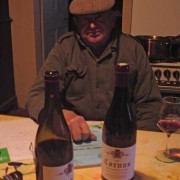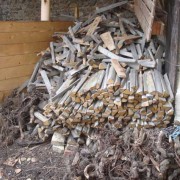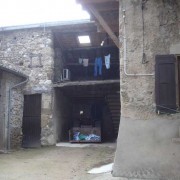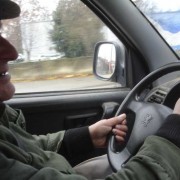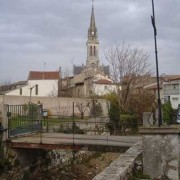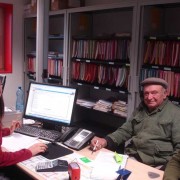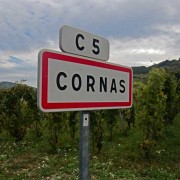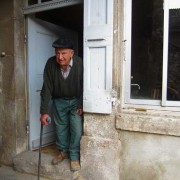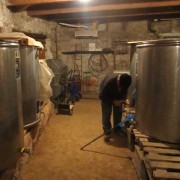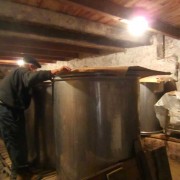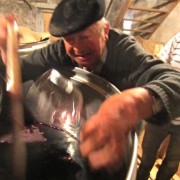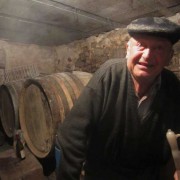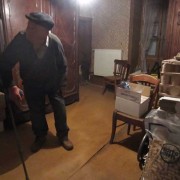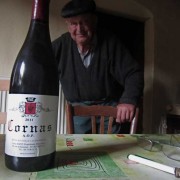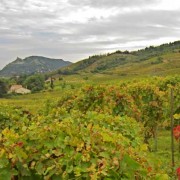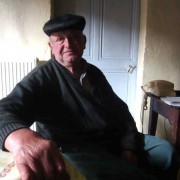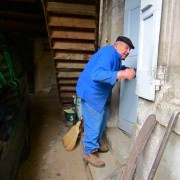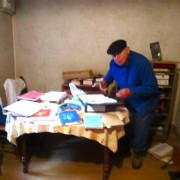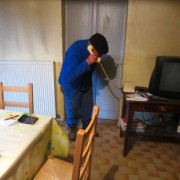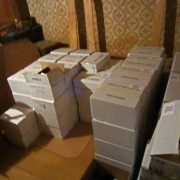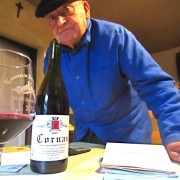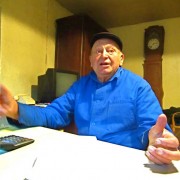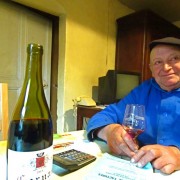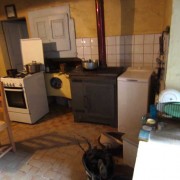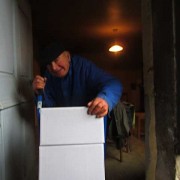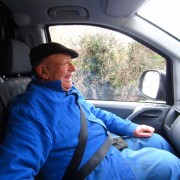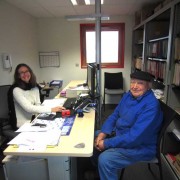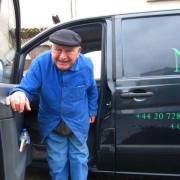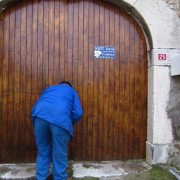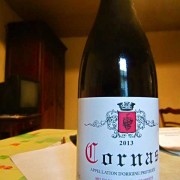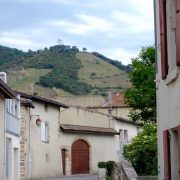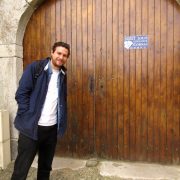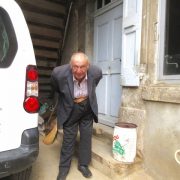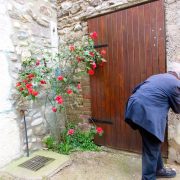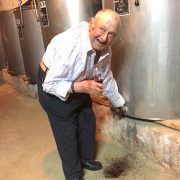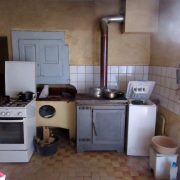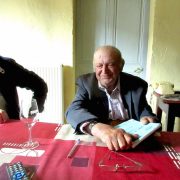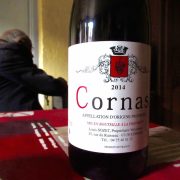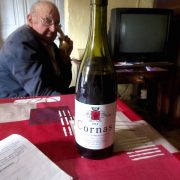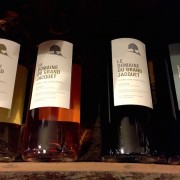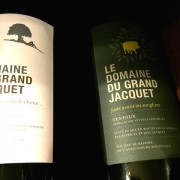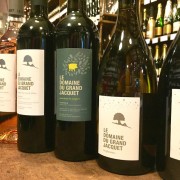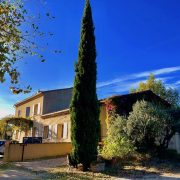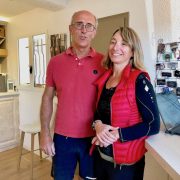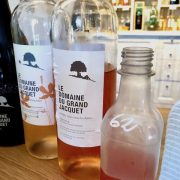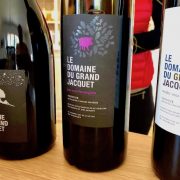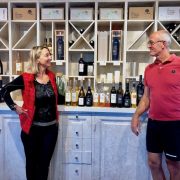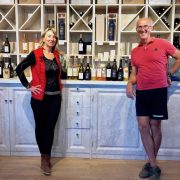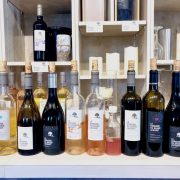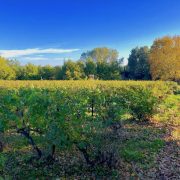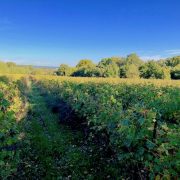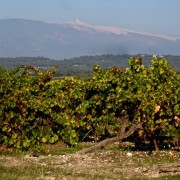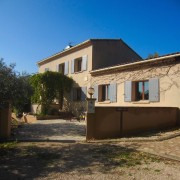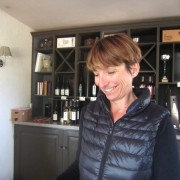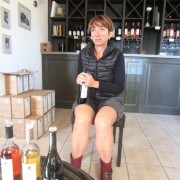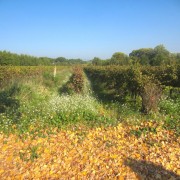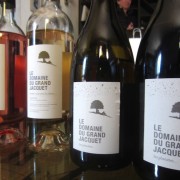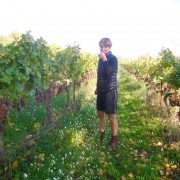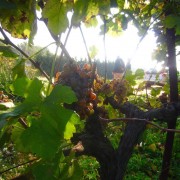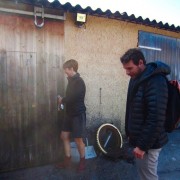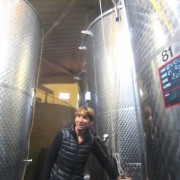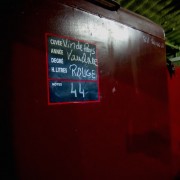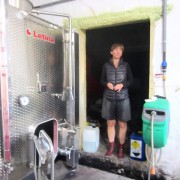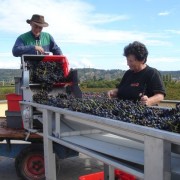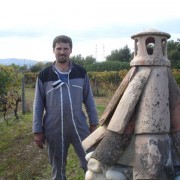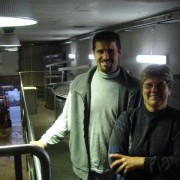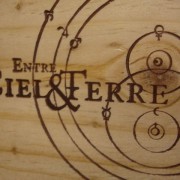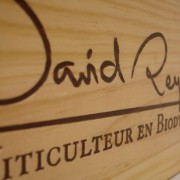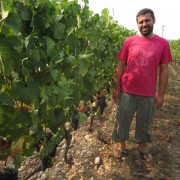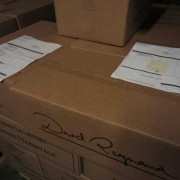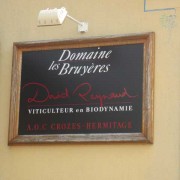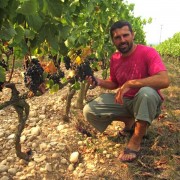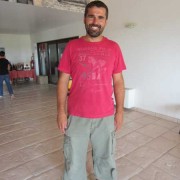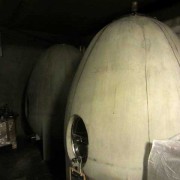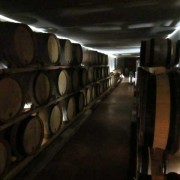Domaine Banneret (Chateauneuf-du-Pape) ORGANIC
One night in La Mere Germaine, having despatched a Henri Bonneau Chateauneuf the night before, our friendly host Andre asked, “have you ever tasted Banneret?” No we hadn’t. It was soon remedied and the 1998 kept us entertained for the next hour with its unreconstructed, unapologetic, wild, sweaty traditional style. We were warned that Jean-Claude Vidal can be a bit gruff, so we were nervous when we knocked on his garage door the following day. “I use every one of the 13 varieties in my wine and that poster you are looking at is wrong.” So what are the grapes in the 13-grape Symphony? The poster states: Grenache, Syrah, Mourvedre, Cinsault, Muscardin, Cournoise, Clairette, Bourboulenc, Picpoul Blanc, Roussanne, Terret Noir, Picardan, Vaccarese. Jean-Claude says Picpoul Blanc has never been cultivated here, but you can still find old vine Picpoul Noir.
Is this one of the only truly authentic Chateauneufs still being made? These are fascinating, wild wines. Refreshingly expensive. Slick they’re not. Gruff, muscular, powerful, like something that’s crawled out of the undergrowth. We love them.
Aurelien Chatagnier (Saint-Pierre-de-Boeuf) ORGANIC
Aurelien says he was “bad at school” and, when he was 16, his mother said he should probably knock it on the head and get a job. He went to work for Jamet and then for Francois Villard. He loved it – and especially enjoyed working in the vines.
In 2002, after a gentle, encouraging nudge from Villard, he set up on his own, starting with just a single hectare. He now has 7.5 hectares and is making wonderful, expressive northern Rhone wines. Viognier, Condrieu, Saint-Joseph in white. In red, there’s a Syrah, three cuvees of Saint-Joseph, Cornas and a tiny amount of Cote-Rotie.
He still doesn’t make much and it took over two years to claw some bottles from his grip – not helped by the fact that, back in 2016, thieves broke into his remote winery and made off with most of his 2015s, including cases earmarked for us. Apparently this is a frequent occurrence in the region. The good news is that our latest two hits of Aurelien’s pure, modern Viogniers and Syrahs made it out of “Dodge” to The Winery intact.
The Saint-Joseph reds are heady, with violets and black pepper. Voluptuous, with deep, saturated, silky fruit and an adult, savoury, tapenade twist.
The Condrieu and Viognier are expressive and open, with classic floral and apricot stone notes.
Pascal Chalon (Tulette) BIODYNAMIC
In 2007 we stumbled across a young man not far from Chateauneuf-du-Pape called Pascal Chalon, making biodynamic Côtes-du-Rhone-Villages in his Granny’s garage. (Biodynamic = the extreme end of organic, ruled by the lunar calendar)
We clambered around, amongst the tools and apples, squeezed ourselves around her beaten-up Renault and, as soon as we had tasted his two wines, “La Petite Ourse” and “La Grande Ourse”, were quick to back the van up and load the last 9 cases he had. La Petite Ourse is 60% Syrah and 40% Grenache, has a meaty nose, then really pure fruit and supple tannins. La Grande Ourse has some old-vine Mourvedre in the mix. To be more precise: 49% Grenache, 23% Mourvèdre, 13% Syrah, 12% Carignan, 3% Counoise and Muscardin. Ursa Major is 80% old vine Grenache and 20% Carignan and built for the long haul.
More recently, he has added a broad, nutty, oily white; 75% Grenache Blanc, 15% Roussanne, 10% Bourboulenc with the tiniest splash of Ugni Blanc and using wild yeasts.
When we visited him late 2019, in the middle of a tempest, Pascal told us about the name and label changes afoot. There is no cause for alarm – the wines are the same, but all his wines will now carry the Grande Ourse label. The former Petite Ourse still exists but with a different name. The 2017 (which has just arrived) still has a white label. The 2018 will carry a black label and, to make it harder to distinguish from the Grande Ourse (which already has a black label), it will also carry the Grande Ourse name. Confused? Yes. The clue will be on the back label. The former Petite Ourse will feature (in small print) Visan on the back label. La Grande Ourse will be labelled Suze la Romane.
Potential confusion aside, his wines are always pure, biodynamic Rhone heaven – fragrant and gutsy.
Saint-Siffrein – Claude Chastan (Chateauneuf-du-Pape) ORGANIC
Chateauneuf-du-Pape is all about the stones. We dropped in on Saint-Siffrein again, who we had worked with some years ago. They are on the road from Chateauneuf to Orange. Claude Chastan’s son Cyril and daughter Patricia have taken over. Cyril is making the wine now. We got a bit nervous when he started talking about new barrels and modern techniques. We need not have worried: fudres retain pride of place and he still uses whole cluster fermentation, providing plenty of old-school bite and backbone.
They make Chateauneuf-du-Pape in red and white. The red, a blend of 65% Grenache, 15% Syrah, 15% Mourvedre and 5% Cinsault, has become more supple. The vines average 50 years old. The white is charming; 35% Grenache Blanc, 30% Clairette, 15% Roussanne, 15% Bourboulenc and 5% Picpoul. They also bottle a serious Cotes-du-Rhone Villages, 80% Grenache, 20% Syrah from 30-40 year-old vines just the other side of the road from the Chateauneuf appellation.
Their top bottling of Chateauneuf-du-Pape is Terre d’Abel which includes 55% Mourvedre from 100 year-old vines planted by Cyril and Patricia’s Grandfather.
They have farmed organically for 30 years and were certified in 2009.
Domaine Coriancon – Francois Vallot (Vinsobres) BIODYNAMIC
Many of us have heard of Gigondas, and Vacqueyras, fewer have heard of Vinsobres, which is another of the named Cotes-du-Rhone-Villages, all satellites of Chateauneuf-du-Pape. There’s a treat in store. The heavily moustachioed François is a fourth-generation winemaker and owns one of the smallest, oldest Domaines in the Cotes-du-Rhone, an area where much of the wine is bottled by the big co-operatives. Since our first visit he has turned “Bio”. Excellent. So everything from 2003 was officially organic. The previous 5 years were “in conversion”, which is the transitional period before you can be certified as organic. From 2004 they were certified Demeter – the biodynamic certification. In 2013 his daughter Anais returned from a hotel career, a spell studying wine at university and a stage at Yquem in Sauternes and has become the first woman to run the domaine. The domaine is in Vinsobres, one of the named Cotes-du-Rhone-Villages, like Gigondas, Vacqueyras, Cairanne, all satellites of Chateauneuf-du-Pape. It’s a beautiful, warm, windswept setting with the jagged Dentelles de Montmirail and Mont Ventoux as a backdrop. The Vallots’ Grenache and Syrah vines are twisted and beaten-up (rather than caressed) by Le Mistral. Despite the two stage conversions, the style remains unreconstructed traditional, chunky, deep reds packed with enough dark matter for the long haul.
Domaine de la Garance (Rasteau)
Andre and Jos Liautaud’s Domaine de la Garance (named after a climbing plant with small yellow flowers Eng. Madder/Rubia) is in Rasteau. Rasteau is one of the named Cotes-du-Rhone Villages, the villages that fan out across the striking landscape of the southern Rhone valley between Chateauneuf-du-Pape and the hills and mountains to the east – the jagged Dentelles de Monmirail and the imposing Mont Ventoux. It’s a windy place – a hot, dusty wind in summer turns bone-chilling in winter. The wind has a name; Le Mistral. The vines are weather-beaten and gnarly – the wines are muscular and deep. Andre and Jos have vines in Rasteau and nearby Seguret. In addition to the two Cotes-du-Rhone Villages, they also have a mature Cotes-du-Rhone. We don’t find them often; most is consumed within a couple of years of release. 100% Grenache from Seguret’s gravelly soil – butch and chewy. Catch it while you can.
Maxime Chomel (Gervans)
We first stumbled upon Maxime Chomel’s Crozes doing some research in a shop in Tain l’Hermitage. A visit followed. In spite of having SatNav, his place was very hard to find. The trail ran cold along virtually every lane exiting above the village of Gervans just north of Tain. Eventually we found our way through to Monsieur Chomel’s Eagles’ Nest.
Maxime’s father and grandfather had a hectare of apricot trees and, when Maxime took over in 1984, he bought vineyards and taught himself how to make wine. He now has 8.5 hectares, most around his secluded domaine on sandy lœss and granite.
We love the unreconstructed style of his Crozes-Hermitage. Pure Syrah – gently sweaty, evocative of meat and violets.
Louis Sozet (Cornas)
Truffle and violet-soaked Syrah from 75 year-old Louis Sozet. We were his first visitors from England and his first export. No wife, no kids and living in his Grandfather’s house, untouched for decades. A throwback to another age.
What brought us to his door? The adventure began a year earlier when we had a couple of hours to kill and decided to visit Cornas, poke around and look for lunch. Luckily the only place open in Cornas one cold December lunchtime was Villa Rouge. The French are masters of salad – served with lardons, poached egg and melted chevre. One wall has a good selection of wines from Cornas. A good place to do some research. Among the well-known names nestled bottles from growers we had never heard of including Louis Sozet. The lady at the restaurant told us, “he’s a sweet old boy, no wife, no kids. Still makes his wine.”
Cornas, from the southern end of the northern Rhone – opposite bank and down a bit from Hermitage and Crozes-Hermitage can be hard as nails young. Not so here. We brought a bottle of 2006 back to The Winery, loved it and started the courtship a few weeks before our next trip. Our French colleague Ben said, when he finally got through on the phone, “I can barely understand him, his accent is super-thick Ardechois”. What chance did we have? We thought that an order and a date was made but couldn’t be sure.
We arrived at the appointed time, wandered into the yard, small van, tractor, washing hanging up high. Flat-capped and bent double, Monsieur Sozet emerged from a doorway, and invited us in. One table, three chairs, one TV, a cooker with two pots, one light bulb, a kitchen sink from the 1800s. We felt like time travellers.
Right, he said, I’ve spoken to the Customs. (Oh dear, we thought, this may get complicated). He had never exported before. “I need these Excise numbers”. No problem. He wrote them down. We tasted the 2006 (mmmm, truffley) and the 2008 (mmmm violetty). Did we hear old vines? Yes, some of them are over 100 years old.
Right, I’m just going to phone the Customs. His phone, hardly surprisingly, was rotary dial. Right, we just need to go up there and then you can take the wine. We’ll go in my van, it’s only 5 minutes up the road in Tain (which he pronounces “Tayng”). For the next 30 minutes he drove in 2nd gear at 20kms per hour on the Route Nationale, lorries honking and overtaking. “I drive slow but I always get there”, he said – more than once.
The lady at Customs was charming and helpful. Long story short, same in reverse and two and a half hours later we were on our way.
Oh, and the tractor? Yes, I still use it – just on the slightly flatter bits.
Domaine de Fauterie (Saint-Peray) ORGANIC
The Villa Rouge in Cornas is a handy place for lunch. We often get that salad that is a bit like breakfast on a salad. Lardons, poached egg, toast and tomatoes on a bed of lettuce. Hey, it is a salad! The staff are friendly and there is also a good selection of local wines. We found Louis Sozet’s Cornas here. We also came across Sylvain Bernard’s Domaine de Fauterie here. Sylvain is in Saint-Peray, just 1 km south of Cornas, the southernmost village of the northern Rhone (in wine geography). Many of you will know that we are increasingly drawn to the more traditional, muskier end of the French wine spectrum, shying away from modern super-juicy, oaky styles. Sylvain’s wines are just that. Proper face-slapping, sweaty Syrah.
He has between 8 and 9 hectares. 2.6 hectares of white in Saint-Peray – Marsanne and Roussanne planted in 1984 and 1986, 4.5 hectares of Saint-Joseph planted in 1982 and 1 hectare of 120 year-old vines in Cornas. He makes two Saint-Joseph bottlings. A regular Domaine Cuvee and Les Combaud, from a parcel in Glun above Courbis. He also bottles two very old vine Cornas, the Domaine and the Cuvee H, which stands for Hauts and spends 28 months in oak. No new oak – he tends to use 2/3/4 year-old barrels. His Saint-Peray is a classic, broad, Rhone white – usually 70% Marsanne and 30% Roussanne.
Sylvain has been working organically for decades and finally got the certification in 2012.
Grand Jacquet (Ventoux) ORGANIC
The impressive and distinctive Mont Ventoux towers over the Ventoux, as it does over the whole southern Rhone valley.
Grand Jacquet has been on our radar for some years. Our colleague Ben’s family lives nearby and frequently picked up wine from them. The best-known restaurant in the area, Chez Serge in Carpentras, features their wines heavily: it was only a matter of time before we stopped circling and called-in.
Patricia and Joel Jacquet started their winery in 2000 and have been organic since 2002. They use the lunar calendar. Joel’s parents previously grew fruit and veg on the property. Patricia and Joel have added several small parcels around the village of Mazan and have accumulated 15 hectares.
We were blown-away by their beautifully fragrant, organic reds with evocative names such as Rendez-vous sous le chene (rendezvous under the oak tree) and Juste avant les sangliers (just before the wild boars). The Rendez-vous sous le chene white is 70/30 Grenache Blanc/Roussanne, the Rose is 100% Grenache. The red is 80% Grenache, 20% Syrah and reminiscent of lavender and violets. Their “Juste avant les sangliers” comes from a rocky vineyard at an altitude of 380 metres. They leave the grapes to ripen as long as possible before the wild boars go crazy and storm the vineyard. The blend is 60/40 Syrah/Grenache with 12 months in oak. The wine has a deep herbal, garrigue nose (garrigue is the name of the low, scrubby bushland in the area, evoking warm earth with notes of rosemary, lavender and thyme. Les Planetes white is barrel-fermented 50/50 Grenache Blanc and Roussanne with long lees contact. They only make Les Planetes red in the best years – 80/20 Syrah/Grenache from very old vines.
Domaine des Bruyeres – David Reynaud (Beaumont-Monteux) BIODYNAMIC
Crozes-Hermitage comes from the gentle incline to the south of the hill of Hermitage, at Tain on the banks of the Rhone. White Crozes is made from Marsanne often with a splash of Roussanne. Red Crozes is 100% Syrah.
Trying to find David Reynaud’s Domaine was the catalyst for us investing in Sat Nav. Pre TomTom, we got quite lost, criss-crossing the wide Rhone, finding ourselves outside hydro-power stations and then in the middle of nowhere. Eventually David’s mother Marceline was despatched to retrieve us from the village playground. Marceline took over her in-laws’ vines in 1998. Her husband has no interest in the soil and remains a local banker. Her son David joined her in 2000 and they decided to go biodynamic. First vintage was 2003. Serious wines. Big, but not too big, thanks to the cooling effect of the mountains. Mountains that were not visible that rainy day.
When we visited again recently, in the sweltering late August heat, we spotted his latest Viognier and Syrah, tasted them and promptly added both to our pallet (which also included his new Cornas). The other thing we spotted in the cellar was a red St Joseph 2011 which will be released in 2013.
Cascavel (Ventoux)
The Mont Ventoux towers over the southern part of the Rhône valley which embraces Chateauneuf-du-Pape and the Cotes-du-Rhône Villages. Although very much in a similar style, the Ventoux has become a very trendy, upcoming sub-region, much to the dismay of the gun-toting, red-necked locals. We had been circling Domaine de Cascavel for almost a decade. The urbane Raphaël Trouiller originally set up Domaine Cascavel in the mid-1990s with the highly-strung Olivier Baguet. They went their separate ways in the early 00s and we are increasingly delighted with Raphaël’s output – two whites; the fruity, bright Elicio Blanc from 100% Vermentino, the nutty, oily In Fine Blanc made with 80% Clairette and 20% Bourboulenc. Three fruity roses and (currently) four spicy, herbal reds; Elicio Rouge (50/50 Grenache/Merlot), In Fine Rouge (90% Grenache and 10% Syrah), Le Cascavel (40% Grenache, 40% Carignan, 20% Syrah) and Leonor (50/50 Grenache/Syrah) evocative of the lavender and thyme-laden local landscape.
Bernard Levet (Ampuis)
We had searched and searched for a Cote Rotie, (the “roasted slope”) that really turned us on, and kept running until we came across Bernard Levet’s wine. A depth-charge of dark brooding fruit hits you from the off, Syrah in fifth gear, the volume up to eleven, then free-wheeling downhill the rest of the way. No Viognier here to detract from 100% sheer vinous Syrah pleasure. Animal sweat and meat mingles with violets in the nose, savage power and weight in the mouth and yet finishing with elegance. Daughter and collaborator Agnes showed us every parcel of their small 4 hectare holding spread across the steep slopes of the Cote Blonde and the Cote Brune (including the legendary La Landonne) in the biting wind.
Coursodon (Mauves)
St Joseph is a large Appellation running a distance of 50kms along the west bank of the Rhone south of Lyon from Condrieu down to Valence. The sweet-spot is here in Mauves, on the opposite bank to Hermitage, and this is where you can find the church, which gives St Joseph its name. Although it carries his father’s name, Jerome Coursodon, the 30-something son, and his mother seem to do everything. Jerome in the cellar, his mum in the office and the tasting room. The wines are state-of-the-art northern Rhone.
White St Joseph, Marsanne with a tiny splash of Roussanne, can sometimes be a bit heavy but to preserve freshness, Jerome Coursodon often stops the secondary malolactic fermentation. These are fascinating white wines, with depth, concentration and notes of apricot and acacia. Red St Joseph is 100% Syrah. Jerome makes beautifully pure Syrah. Effortlessly polished. L’Olivaie is his top bottling. All violets and vanilla cream when young, with some age it can become sweatier and more macho.
Domaine de la Ronciere – Jean-Louis Canto (Chateauneuf-du-Pape)
The small town of Chateauneuf-du-Pape near Orange in the hot windswept south of France is the epicentre of the southern Rhone and well-known for its big, bold, sometimes dusty reds. Jean-Louis and Martine Canto make Chateauneuf-du-Pape in both colours, a violetty-peppery Cotes du Rhone and a deep, more serious Reserve. All of their reds are Grenache-heavy with Syrah and occasionally a splash of Mourvedre for that added dark twist. Top of the range is their Chateauneuf-du-Pape “Flor de Ronce” from a small parcel of 100 year-old vines on the road to Courthezon.
